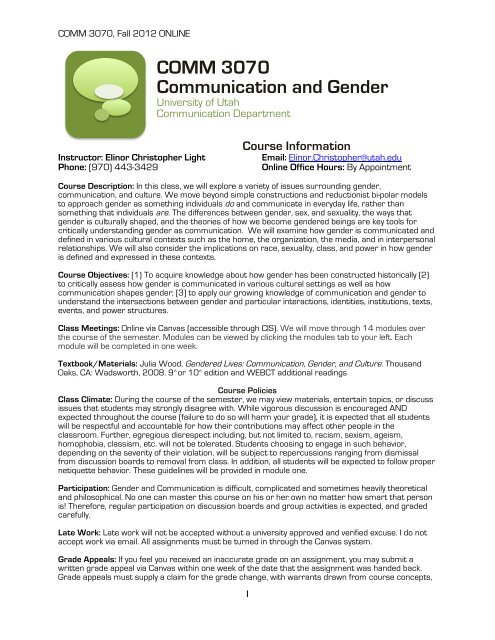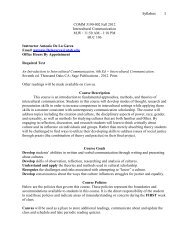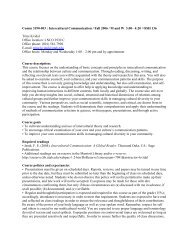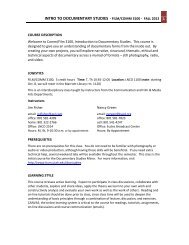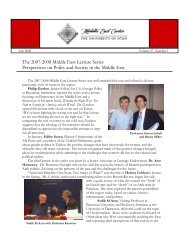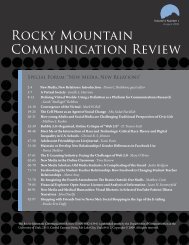COMM 3070 Communication and Gender - humis.utah.edu ...
COMM 3070 Communication and Gender - humis.utah.edu ...
COMM 3070 Communication and Gender - humis.utah.edu ...
You also want an ePaper? Increase the reach of your titles
YUMPU automatically turns print PDFs into web optimized ePapers that Google loves.
<strong>COMM</strong> <strong>3070</strong>, Fall 2012 ONLINE<br />
<strong>COMM</strong> <strong>3070</strong><br />
<strong>Communication</strong> <strong>and</strong> <strong>Gender</strong><br />
University of Utah<br />
<strong>Communication</strong> Department<br />
Course Information<br />
Instructor: Elinor Christopher Light Email: Elinor.Christopher@<strong>utah</strong>.<strong>edu</strong><br />
Phone: (970) 443-3429 Online Office Hours: By Appointment<br />
Course Description: In this class, we will explore a variety of issues surrounding gender,<br />
communication, <strong>and</strong> culture. We move beyond simple constructions <strong>and</strong> r<strong>edu</strong>ctionist bi-polar models<br />
to approach gender as something individuals do <strong>and</strong> communicate in everyday life, rather than<br />
something that individuals are. The differences between gender, sex, <strong>and</strong> sexuality, the ways that<br />
gender is culturally shaped, <strong>and</strong> the theories of how we become gendered beings are key tools for<br />
critically underst<strong>and</strong>ing gender as communication. We will examine how gender is communicated <strong>and</strong><br />
defined in various cultural contexts such as the home, the organization, the media, <strong>and</strong> in interpersonal<br />
relationships. We will also consider the implications on race, sexuality, class, <strong>and</strong> power in how gender<br />
is defined <strong>and</strong> expressed in these contexts.<br />
Course Objectives: [1) To acquire knowledge about how gender has been constructed historically (2)<br />
to critically assess how gender is communicated in various cultural settings as well as how<br />
communication shapes gender; [3] to apply our growing knowledge of communication <strong>and</strong> gender to<br />
underst<strong>and</strong> the intersections between gender <strong>and</strong> particular interactions, identities, institutions, texts,<br />
events, <strong>and</strong> power structures.<br />
Class Meetings: Online via Canvas (accessible through CIS). We will move through 14 modules over<br />
the course of the semester. Modules can be viewed by clicking the modules tab to your left. Each<br />
module will be completed in one week.<br />
Textbook/Materials: Julia Wood, <strong>Gender</strong>ed Lives: <strong>Communication</strong>, <strong>Gender</strong>, <strong>and</strong> Culture. Thous<strong>and</strong><br />
Oaks, CA: Wadsworth, 2008. 9 th<br />
or 10 th<br />
edition <strong>and</strong> WEBCT additional readings<br />
Course Policies<br />
Class Climate: During the course of the semester, we may view materials, entertain topics, or discuss<br />
issues that students may strongly disagree with. While vigorous discussion is encouraged AND<br />
expected throughout the course (failure to do so will harm your grade), it is expected that all students<br />
will be respectful <strong>and</strong> accountable for how their contributions may affect other people in the<br />
classroom. Further, egregious disrespect including, but not limited to, racism, sexism, ageism,<br />
homophobia, classism, etc. will not be tolerated. Students choosing to engage in such behavior,<br />
depending on the severity of their violation, will be subject to repercussions ranging from dismissal<br />
from discussion boards to removal from class. In addition, all students will be expected to follow proper<br />
netiquette behavior. These guidelines will be provided in module one.<br />
Participation: <strong>Gender</strong> <strong>and</strong> <strong>Communication</strong> is difficult, complicated <strong>and</strong> sometimes heavily theoretical<br />
<strong>and</strong> philosophical. No one can master this course on his or her own no matter how smart that person<br />
is! Therefore, regular participation on discussion boards <strong>and</strong> group activities is expected, <strong>and</strong> graded<br />
carefully.<br />
Late Work: Late work will not be accepted without a university approved <strong>and</strong> verified excuse. I do not<br />
accept work via email. All assignments must be turned in through the Canvas system.<br />
Grade Appeals: If you feel you received an inaccurate grade on an assignment, you may submit a<br />
written grade appeal via Canvas within one week of the date that the assignment was h<strong>and</strong>ed back.<br />
Grade appeals must supply a claim for the grade change, with warrants drawn from course concepts,<br />
1
<strong>COMM</strong> <strong>3070</strong>, Fall 2012 ONLINE<br />
<strong>and</strong> evidence in the student’s assignments. I will determine whether your argument is persuasive <strong>and</strong><br />
necessitates the point correction. See http://www.regulations.<strong>utah</strong>.<strong>edu</strong>/academics/6-400.html for<br />
more information on University of Utah grade dispute policies.<br />
University of Utah Policies<br />
American Disabilities Act: The University of Utah seeks to provide equal access to its programs,<br />
services, <strong>and</strong> activities for people with disabilities. If you need accommodations in the class, reasonable<br />
prior notice should be given to the Center for Disability Services, 162 Olpin Union Building, 801-581-<br />
5020 (V/TDD), http://disability.<strong>utah</strong>.<strong>edu</strong>/. CDS will work with you <strong>and</strong> the instructor to make<br />
arrangements for accommodations. All written information in this course can be made available in<br />
alternative format with prior notification to the Center for Disability Services<br />
Academic Honesty: Academic honesty is required of all students. Students found guilty of academic<br />
dishonesty can receive an “E” for the assignment or the course, <strong>and</strong> other disciplinary action may be<br />
taken. I take a strong stance on plagiarism. Plagiarism includes (but is not limited to) intentional<br />
submission of someone else’s work without credit, in part or as a whole; misuse of citations to conceal<br />
a source; use of other course work in this class; <strong>and</strong> other similar behaviors. Please meet with me<br />
immediately if you are unclear as to what constitutes plagiarism. See the following link for more<br />
information: http://www.regulations.<strong>utah</strong>.<strong>edu</strong>/academics/6-400.html.<br />
Content Accommodations: I am able to make sch<strong>edu</strong>le accommodations for those who have a conflict<br />
that involves religious/spiritual observances, University sanctioned activities, <strong>and</strong> personal or medical<br />
exigencies, provided that documentation is furnished. If you anticipate or when you experience any<br />
sch<strong>edu</strong>ling conflict with this course, please speak with me as soon as possible. In every case, it is the<br />
student’s responsibility to make these arrangements. As we study communication in its various forms<br />
<strong>and</strong> contexts, we will apply the concepts we engage to a variety of examples, including those that occur<br />
in the venue of popular culture. Some students may find some of the reading materials, presentations,<br />
lectures, or audio/visual materials controversial or in conflict with their values or beliefs. Please be<br />
assured that all the material that I present, assign, or require you to encounter <strong>and</strong> address has been<br />
selected for its pedagogical value <strong>and</strong> utility in relation to the concepts we are engaging. I will not make<br />
content accommodations for this material. It is your responsibility to review the syllabus, readings,<br />
assignments, <strong>and</strong> materials to be sure that this is a course you wish to take. Should you have<br />
questions or concerns, please see me immediately. Details on the university’s accommodation policy<br />
are available at this link: http://www.admin.<strong>utah</strong>.<strong>edu</strong>/facdev/pdf/accommodations-policy.pdf<br />
Drop/Withdrawal Policy: Please check the Fall 2012 academic calendar for information pertaining to<br />
dropping <strong>and</strong> withdrawing from a course. See the following link for more information:<br />
http://registrar.<strong>utah</strong>.<strong>edu</strong>/academic-calendars/fall2012.php or<br />
http://registrar.<strong>utah</strong>.<strong>edu</strong>/h<strong>and</strong>book/withdrawal.php<br />
FERPA: The Family Educational Rights <strong>and</strong> Privacy Act (FERPA) states that a student’s <strong>edu</strong>cational<br />
records must be kept private unless the student authorizes their release. Instructors may not disclose<br />
grades to others, for example by posting grades outside an office door, revealing them in class, or<br />
discussing them with a parent. See http://registrar.<strong>utah</strong>.<strong>edu</strong>/h<strong>and</strong>book/ferpa.php.<br />
Grading<br />
A grade of “A” represents excellent work in which evidence of exceptional quality <strong>and</strong> in-depth, complex<br />
comprehension of the subject is clearly demonstrated. “B” work indicates competent work that shows<br />
a strong grasp of the course goals without being distinguished. “C” s indicates work of adequate<br />
quality, which may be incomplete or inaccurate in one respect. “D” grades indicate that the<br />
requirements have been minimally satisfied <strong>and</strong> are incomplete or inadequate in more than one<br />
respect. “F” grades are given when the requirements have not been met.<br />
Final Grade Breakdown out of 500 possible points:<br />
A =100-94% (468 <strong>and</strong> up)* A- = 93-90% (448-467) B+ = 89-87% (433-447)<br />
B = 86-84% (418- 432) B- = 83-80% (398-417) C+ = 79-77% (368-383)<br />
C = 76-74% (382-368) C- = 73-70% (367-348) D+= 69-67% (347-333]<br />
D = 66-64% (332- 318 D- = 63-60% (317-298) E = 59% ↓<br />
2
<strong>COMM</strong> <strong>3070</strong>, Fall 2012 ONLINE<br />
Drop/withdrawal Policies: http://www.regulations.<strong>utah</strong>.<strong>edu</strong>/academics/6-400.html<br />
Course Assignments<br />
Discussion Board <strong>and</strong> Activities (75 points): 15% of your final grade is based on (1) Discussion<br />
board response to prompt for each module <strong>and</strong> at least 2 responses to other student’s posts (3<br />
points/module). Student responses must be competed by the last day of the module. There are NO<br />
makeups for these points unless sanctioned by University policy. (2) Demonstration of reading<br />
comprehension in responses (determined at the end of the semester out of 20 points) <strong>and</strong> 3)<br />
Completion of a peer review of another student’s final analysis paper worth 10 points.<br />
Think Pieces (3 @ 25 points each=75): 15% of your final grade is based on three 2-3 page, doublespaced,<br />
analytical reaction papers to a specific discussion prompt that I will provide. These papers will<br />
be graded either “Excellent” (plus, 25pts.), “satisfactory” (check, 20 pts.) or “unsatisfactory” (minus,<br />
15pts). I will be looking for depth of thought, clarity of ideas, application <strong>and</strong>/or integration of readings<br />
<strong>and</strong> lecture material, <strong>and</strong> overall readability.<br />
Analysis Paper (100): 20% of your grade is based on this assignment. You will select a cultural<br />
artifact that you would like to analyze—something which interests or intrigues you. An artifact could be<br />
a written document, but also (<strong>and</strong> not limited to) an advertisement, a film or TV show, a space, a song,<br />
an object (such as a painting), or a website. You will write a 6-8 page paper with at least 6 outside<br />
(academic) sources, not including the text under analysis. You will situate your chosen text within its<br />
social or historical context, discuss what the text communicates about gender, <strong>and</strong> discuss what the<br />
implications of such communication are in our cultural underst<strong>and</strong>ings of gender.<br />
<strong>Gender</strong> Portfolio (125): 25% of your final grade is based on this assignment. Rather than a final<br />
exam, you will collect material <strong>and</strong> artifacts over the course of the semester that illustrate ideas<br />
relevant to gender <strong>and</strong> communication. By the end of the semester, you will compile these resources<br />
into a PDF file or PowerPoint presentation. Each page of your document will include a photograph,<br />
copy, or description of the artifact <strong>and</strong> a complete paragraph (at least a paragraph, but no more than<br />
a page] addressing what the artifact tells us about gender <strong>and</strong> communication. Each artifact should be<br />
directly connected to course content <strong>and</strong> you should cite sources appropriately <strong>and</strong> include a Works<br />
Cited page. You will write a conclusion to your portfolio that reflects on the process of this assignment.<br />
You must have 25 artifacts <strong>and</strong> they can include (but are not limited to):<br />
• Movie clip, or a scene from a movie or TV show (include link <strong>and</strong> still shot of movie/scene)<br />
• Song clip or song lyrics<br />
• Copy of article, excerpt, or ad from a magazine or newspaper<br />
• Website<br />
• Photograph or painting*<br />
• Cartoon<br />
• Description of personal experience<br />
*If you find something that is not in electronic format, take a photo of it <strong>and</strong> paste it into your<br />
document<br />
Quizzes (125 pts.): 25% of your final grade is based on 14 short quizzes, which draw from both<br />
lecture <strong>and</strong> reading material throughout the course. You must take the quiz before the end of each<br />
module.<br />
3
<strong>COMM</strong> <strong>3070</strong>, Fall 2012 ONLINE<br />
Module Topics <strong>and</strong> Sch<strong>edu</strong>le<br />
Module Dates Topics Readings To Do<br />
Module August 20- <strong>Gender</strong>,<br />
-Wood, Intro <strong>and</strong> Chapter -Introduce yourself on the<br />
1<br />
26<br />
communication <strong>and</strong> 1<br />
Introductions board<br />
Contemporary Culture -Syllabus<br />
-Discussion Board 1<br />
-Netiquette<br />
-West & Zimmerman<br />
-Module 1 Quiz<br />
Module 2 August 27- Theories of <strong>Gender</strong> -Wood, Chapter 2 -Discussion Board 2<br />
September 2<br />
-Warnke<br />
-Think Piece 1<br />
Assignment<br />
-<strong>Gender</strong> Portfolio<br />
Assignment<br />
-Module 2 Quiz<br />
Module 3 September Women’s Movements -Wood, Chapter 3 -Discussion Board 3<br />
3-9<br />
-Fudge<br />
-Curry-Johnson<br />
-Module 3 Quiz<br />
Module 4 September<br />
10-16<br />
Module 5 September<br />
17-23<br />
Module 6 September<br />
24-30<br />
Men’s Movements -Wood, Chapter 4<br />
-Kimmel<br />
-Kimmel & Messner<br />
<strong>Gender</strong>ing -Wood, Chapter 7<br />
-Gould<br />
<strong>Gender</strong> <strong>and</strong><br />
Verbal/Nonverbal<br />
<strong>Communication</strong><br />
Module 7 October 1-7 <strong>Gender</strong>, Family, <strong>and</strong><br />
Relationships<br />
4<br />
-Wood, Chapter 5 <strong>and</strong> 6<br />
-Spender<br />
-Think Piece 2<br />
Assignment<br />
-Wood, Chapter 9<br />
-Syfers<br />
-Greenberg<br />
-Wood, Chapter 8 <strong>and</strong><br />
10<br />
Module 8 October 15- <strong>Gender</strong>, Education, <strong>and</strong><br />
21<br />
the Organization<br />
Module 9 October 22- <strong>Gender</strong> <strong>and</strong> the Media -Wood, Chapter 11<br />
28<br />
-Kilbourne<br />
-Shugart<br />
-Analysis Paper<br />
Assignment<br />
Module 10 October 29- <strong>Gender</strong> <strong>and</strong> the Body -Bordo<br />
November 4<br />
-Dworkin & Wachs<br />
-Think Piece 3<br />
Assignment<br />
Module 11 November 5- <strong>Gender</strong> <strong>and</strong> Sexuality -Cooper<br />
11<br />
-Ott <strong>and</strong> Aoki<br />
-Rich<br />
Module 12 November <strong>Gender</strong> <strong>and</strong><br />
-hooks<br />
12-18 Race/Ethnicity -Guzman & Valdivia<br />
-Joseph<br />
-Orbe<br />
Module 13 November <strong>Gender</strong>, Power, <strong>and</strong> -Wood, Chapter 12<br />
19-25 Violence<br />
-Berger<br />
Module 14 November<br />
26-<br />
December 2<br />
Course<br />
Conclusions<br />
December 3-<br />
7<br />
Moving Toward a More<br />
Equitable Society<br />
-Discussion Board 4<br />
-Module 4 Quiz<br />
-Think Piece 1 Due<br />
-Discussion Board 5<br />
-Module 5 Quiz<br />
-Discussion Board 6<br />
-Module 6<br />
Quiz<br />
-Discussion Board 9<br />
-Module 9 Quiz<br />
-Discussion Board 8<br />
-Module 8 Quiz<br />
-Discussion Board 9<br />
-Module 9 Quiz<br />
-Think Piece 2 Due<br />
-Discussion Board 10<br />
-Module 10 Quiz<br />
-Discussion Board 11<br />
-Module 11 Quiz<br />
-Discussion Board 12<br />
-Module 12 Quiz<br />
-Think Piece 3 Due<br />
-Discussion Board 13<br />
Module 13 Quiz<br />
- Peer Review Due<br />
-West -Discussion Board 14<br />
-Module 14 Quiz<br />
-Analysis Paper Due<br />
-None -None -Review Grades<br />
- <strong>Gender</strong> Portfolio Due
<strong>COMM</strong> <strong>3070</strong>, Fall 2012 ONLINE<br />
Additional Reading List<br />
Bordo, Susan. “Reading the Slender Body.” Unbearable Weight: Feminism, Western Culture, <strong>and</strong> the<br />
Body. Berkeley, CA: University of California, 1993. 185-212.<br />
Cooper, Brenda. “Boys Don't Cry <strong>and</strong> Female Masculinity: Reclaiming A Life And Dismantling The<br />
Politics of Normative Heterosexuality.” Critical Studies in Media <strong>Communication</strong> 19 (2002):<br />
44-63.<br />
Dworkin, Shari L. <strong>and</strong> Wachs, Faye L. “Size Matters.” Body Panic: <strong>Gender</strong>, Health, <strong>and</strong> the Selling of<br />
Fitness. Ed. S. L Dworkin & F.L. Wachs. New York: New York University Press. (2009). 65-<br />
105.<br />
Fudge, Rachel. “Everything You Always Wanted To Know About Feminism But Were Afraid To Ask.”<br />
Bitch 31 (2006): 58-67.<br />
Gould, Lois. “X: A Fabulous Child’s Story.” <strong>Gender</strong> Images: Readings for Composition. Ed. M. Schaum &<br />
C. Flanagan. Boston: Houghton Mifflin, 1992. 6-19.<br />
Guzmán, Isabel M. <strong>and</strong> Valdivia, Angharad N. “Brain, Brow, <strong>and</strong> Booty: Latina Iconicity in U.S. Popular.”<br />
<strong>Communication</strong> Review 7 (2) (2004): 205-221.<br />
hooks, bell. “Reflections on Race <strong>and</strong> Sex.” Yearning: Race, <strong>Gender</strong>, <strong>and</strong> Cultural Politics. Boston: South<br />
End., 1990. 57-64.<br />
Joseph, Ralina L. “'Tyra Banks Is Fat': Reading (Post-)racism <strong>and</strong> (Post-)feminism in the New<br />
Millennium.” Critical Studies in Media <strong>Communication</strong> 26 (3) (2009): 237-254.<br />
Kilbourne, Jean. “Beauty <strong>and</strong> the Beast of Advertising.” <strong>Gender</strong>, Race, <strong>and</strong> Class in Media. Eds. G.<br />
Dines <strong>and</strong> J. M. Humez. Thous<strong>and</strong> Oaks, CA: Sage, 1995. 121-125.<br />
Kimmel, Michael <strong>and</strong> Messner, Michael. “Men as <strong>Gender</strong>ed Beings.” Issues in Feminism. Ed. S. Ruth<br />
Mountain View, CA: Mayfield, 1990. 56-58.<br />
Ott, Brian <strong>and</strong> Aoki, Eric. “The Politics of Negotiating Public Tragedy: Media Framing of the Mathew<br />
Shepard Murder.” Rhetoric & Public Affairs 5(3) (2002): 483-505.<br />
Orbe, Mark P. “Constructions of Reality on MTV’s ‘The Real World’: An Analysis of the Restrictive<br />
Coding of Black Masculinity.” Southern <strong>Communication</strong> Journal 64 (1998): 32-47.<br />
Shugart, Helena .A., & Waggoner, Catherine E. “Gwen Stefani: Camp Vamp.” In Making Camp:<br />
Rhetorics of Transgression in U.S. Popular Culture. Birmingham, AL: University of Alabama<br />
Press, 2008: 119-141.<br />
Spender, Daniel. “Language <strong>and</strong> Reality: Who Made the World?” In Man made language. London:<br />
Routledge & Kegan Paul, 1985. 139-162.<br />
Syfers, Judy. “I Want a Wife.” The gender reader. Eds. Ashton-Jones, Olsen, & Perry (Eds.), (2nd ed).<br />
Boston: Allyn <strong>and</strong> Bacon Publishers, 2000.390-393.<br />
Warnke, Georgia. “The Tragedy of David Reimer.” After Identity: Rethinking Race, Sex, <strong>and</strong> <strong>Gender</strong> (pp.<br />
15-48). Cambridge, MA: Cambridge University Press, 2007.<br />
5
<strong>COMM</strong> <strong>3070</strong>, Fall 2012 ONLINE<br />
West, C<strong>and</strong>ace <strong>and</strong> Zimmerman, Don. “Doing gender.” <strong>Gender</strong> & Society 1(1987): 125-151.<br />
6


